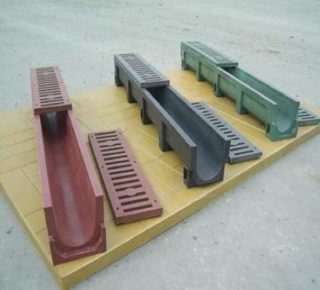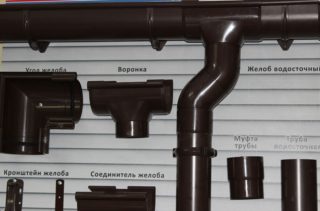A competently executed installation of the drainage system will be able to ensure not only trouble-free operation of the roof, but also the safety of the walls and foundation of the building. Do-it-yourself drainage is in no way inferior to systems made by professionals, provided that all stages of the manufacturing process are carried out accurately and thoroughly.
Installation of polymer gutters
Manufacturers endow their polymer products with the following characteristics:
- frost resistance - the components of the systems do not deform and do not crack at temperatures down to -50 degrees;
- durability - the service life is approximately 15-30 years;
- a high degree of throughput (with proper installation);
- sound absorption - silent movement of all types of precipitation through pipes;
- wear resistance - resistant to corrosion and chemical attack;
- low weight - the ability to carry out installation on lightweight buildings;
- decorativeness - retains an attractive appearance throughout the entire period of operation;
- availability - the cost is lower than that of metal counterparts.
One of the advantages of polymer systems is simplified installation, which does not require special skills and equipment, especially when the structure is assembled by means of rubber seals. All parts have snap locks, and fasteners are mounted to the front board and walls using hardware. Each set of polymer gutters is provided with detailed assembly instructions, but there are general recommendations that must be followed during installation:
- although the material can withstand fairly large frosts, it is not worth assembling at temperatures lower than +5;
- the slope for the polymer gutter should be 3-5 mm per linear meter;
- the maximum gap between the intake funnels is 24 meters;
- place brackets at the same distance;
- the optimal gap from the wall of the house to the pipe is 3-8 cm;
- the gutter should protrude 1/3 part above the roof level.
The assembly of a polymer gutter begins with the installation of a drainage funnel, which is also a connecting element. The level of the slope is maintained using a cord or level. Further, the brackets for the gutters are mounted, starting from the opposite side relative to the funnel.
Brackets and extensions are attached to the frontal board using self-tapping screws 5 × 30 mm. The gutter is installed in the connecting elements and snaps into the grooves. Subject to the implementation of the recommendations for assembly, the drainage system will receive high efficiency during its operation.
Galvanized systems
- resistant to deformation, temperature extremes, humidity;
- fire resistance when exposed to direct flame;
- light weight;
- affordable price with fairly good technical characteristics.
The disadvantage of galvanized gutters is the low degree of sound insulation. Therefore, it is necessary to observe the technology in the manufacture of the system, namely, the fastening of the elements to the roof and facade.
Plastic pipes
- Since this material is more malleable than galvanized steel, fastening here is more frequent and the load is distributed somewhat differently. With the same assembly scheme, the number of parts is much larger.
- The distance between the brackets should not exceed 0.5 m, while in a steel structure it is 0.8-1.3 m. Brackets are attached to the wall of the house, roof rafters, and frontal board.
- The number of pipes for the drain is calculated in the ratio of 1 to 8 m of the gutter. Roof diameter: 1sq. m to 1 sq. see pipe section.
- The gutter is installed in accordance with the angle of inclination of the roof: the water flowing down from the slope must fall on the center line of the drainage channel.
- It is important to choose the correct depth of the gutter. Otherwise, the water will overflow and the gutter will lose its functionality.
- The slope of the gutter is at least 2 cm per linear meter.
- The gap between the wall and the downpipe corresponds to a distance of 3-5 cm.
- The connection of the components is carried out with an overlap and always with the use of seals.
- The distance between the drainage system and the ground should be no more than 15 cm. In winter, water can freeze and form icicles, under the weight of which the plastic is damaged, so the distance here is 2 times less than on a galvanized drain.
- Cleaning of the structure is carried out with a jet of water or air, since metal objects can deform the surface of the gutter and other elements.
It is not recommended to use fittings such as a 90 degree elbow to bypass corners and protrusions. Garbage constantly accumulates in these sections of the drain, and it will be difficult to clean this element with both water and air. Therefore, it is better to take knees with an angle of 115, 135 degrees.
Plastic bottles
You will need a furniture stapler - a tool that is needed to create this type of drainage system, as well as a screwdriver or drill for attaching the brackets to the wall or roof. Installation of roof drainage from plastic bottles consists of several stages:
- Prepare a sketch of the future structure. It will make it possible to determine the number of bottles and the slope of the gutter for its functionality.
- Remove labels and traces of glue from the material at hand with any detergent.
- To make the gutter, use the central parts of the bottles without a bottom and a lid, having previously spread them lengthwise in two halves.
- Fasten the prepared parts with an overlap with a stapler, the width of which is 1-1.2 cm (usually three staples are enough). The connection of the elements can also be performed using wire, having previously made small holes in the blanks.
- For sealing, use ordinary plasticine or some inexpensive sealant.
- Having made the gutters, you need to fix them along the edge of the roof. To do this, holes are drilled in the slate or other roofing material with a screwdriver or drill at a distance of 20-30 cm. At the same distance, holes are made in the gutter using an awl.Next, a wire is passed through the holes, fastening the weir to the roof.
Then you need to collect vertical drainage systems. If the house is small, 2-3 pipes will be enough, sometimes one is installed altogether. First, a cylinder is cut from the central part of the bottle, then the bottom and the neck are cut off from the second so that the tapering part can be inserted into the prepared cylinder. According to this scheme, continue to install containers until the drainage system acquires the required length. For strength, the parts are fastened with a stapler or wire. With the help of brackets, the homemade pipe is firmly fixed on the wall.
Following the recommendations and the sequence of work performed, you can easily make a drainage system from plastic bottles.












